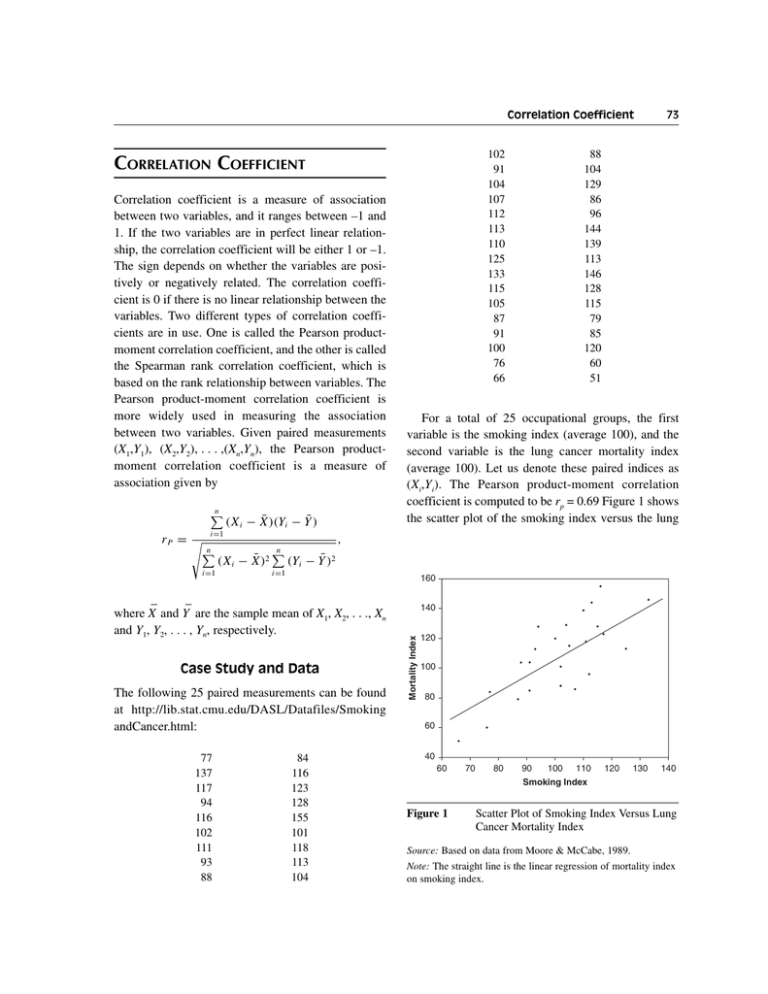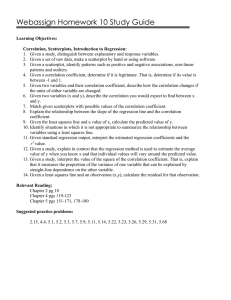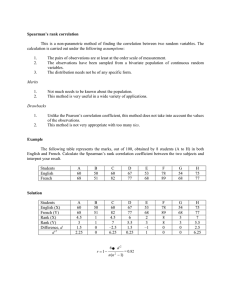C ORRELATION OEFFICIENT
advertisement

Salkind (Ency)-45041_C.qxd 6/22/2006 10:29 PM Page 73 Correlation Coefficient———73 102 91 104 107 112 113 110 125 133 115 105 87 91 100 76 66 CORRELATION COEFFICIENT Correlation coefficient is a measure of association between two variables, and it ranges between –1 and 1. If the two variables are in perfect linear relationship, the correlation coefficient will be either 1 or –1. The sign depends on whether the variables are positively or negatively related. The correlation coefficient is 0 if there is no linear relationship between the variables. Two different types of correlation coefficients are in use. One is called the Pearson productmoment correlation coefficient, and the other is called the Spearman rank correlation coefficient, which is based on the rank relationship between variables. The Pearson product-moment correlation coefficient is more widely used in measuring the association between two variables. Given paired measurements (X1,Y1), (X2,Y2), . . . ,(Xn,Yn), the Pearson productmoment correlation coefficient is a measure of association given by i=1 n ! i=1 (Xi − X̄)(Yi − Ȳ ) (Xi − X̄)2 n ! i=1 (Yi − , Ȳ )2 _ _ where X and Y are the sample mean of X1, X2, . . ., Xn and Y1, Y2, . . . , Yn, respectively. Case Study and Data The following 25 paired measurements can be found at http://lib.stat.cmu.edu/DASL/Datafiles/Smoking andCancer.html: 77 137 117 94 116 102 111 93 88 84 116 123 128 155 101 118 113 104 For a total of 25 occupational groups, the first variable is the smoking index (average 100), and the second variable is the lung cancer mortality index (average 100). Let us denote these paired indices as (Xi,Yi). The Pearson product-moment correlation coefficient is computed to be rp = 0.69 Figure 1 shows the scatter plot of the smoking index versus the lung 160 140 Mortality Index rP = " n ! 88 104 129 86 96 144 139 113 146 128 115 79 85 120 60 51 120 100 80 60 40 60 70 80 90 100 110 120 130 140 Smoking Index Figure 1 Scatter Plot of Smoking Index Versus Lung Cancer Mortality Index Source: Based on data from Moore & McCabe, 1989. Note: The straight line is the linear regression of mortality index on smoking index. Salkind (Ency)-45041_C.qxd 6/22/2006 10:29 PM Page 74 74———Correlation Coefficient cancer mortality index. The straight line is the linear regression line given by Y = β0 + β1· X. The parameters of the regression line are estimated using the least squares method, which is implemented in most statistical packages such as SAS and SPSS. The equation for the regression line is given by Y = – 2.89 + 1.09 · X. If (Xi, Yi), are distributed as bivariate normal, a linear relationship exists between the regression slope and the Pearson product-moment correlation coefficient given by β1 # σY rP , σX where σX and σY are the sample standard deviations of the smoking index and the lung cancer mortality index, respectively (σX = 17.2 and σY = 26.11). With the computed correlation coefficient value, we obtain β1 # 26.11 · 0.69 = 1.05, 17.20 which is close to the least squares estimation of 1.09. Statistical Inference on Population Correlation The Pearson product-moment correlation coefficient is the underlying population correlation ρ. In the smoking and lung cancer example above, we are interested in testing whether the correlation coefficient indicates the statistical significance of relationship between smoking and the lung cancer mortality rate. So we test. H0 : ρ = 0 versus H1 : ρ ≠ 0.. Assuming the normality of the measurements, the test statistic √ rP n − 2 T = % 1 − rP2 follows the t distribution with n–2 degrees of freedom. The case study gives √ 0.69 25 − 2 T = √ = 4.54. 1 − 0.692 This t value is compared with the 95% quantile point of the t distribution with n–2 degrees of freedom, which is 1.71. Since the t value is larger than the quantile point, we reject the null hypothesis and conclude that there is correlation between the smoking index and the lung cancer mortality index at significance level α = 0.1. Although rp itself can be used as a test statistic to test more general hypotheses about ρ, the exact distribution of ρ is difficult to obtain. One widely used technique is to use the Fisher transform, which transforms the correlation into $ # 1 1 + rP . F (rP ) = ln 1 − rP 2 Then for moderately large samples, the Fisher transform is normally distributed with mean # $ 1 1+ρ 1 ln . Then the test statistic is and variance 2 1−ρ n−3 √ n − 3 (F (rP ) − F (ρ)) , which is a standard normal distribution. For the case study example, under the null hypothesis, we have Z= Z= $ # $$ # # √ 1 1+0 1 + 0.69 1 − ln ln 25 − 3 1 − 0.69 2 1−0 2 = 3.98. The Z value is compared with the 95% quantile point of the standard normal, which is 1.64. Since the Z value is larger than the quantile point, we reject the null hypothesis and conclude that there is correlation between the smoking index and the lung cancer mortality index. —Moo K. Chung See also Coefficients of Correlation, Alienation, and Determination; Multiple Correlation Coefficient; Part and Partial Correlation Further Reading Fisher, R. A. (1915). Frequency distribution of the values of the correlation coefficient in samples of an indefinitely large population. Biometrika, 10, 507–521. Moore, D. S., & McCabe, G. P. (1989). Introduction to the practice of statistics. New York: W. H. Freeman. (Original source: Occupational Mortality: The Registrar General’s Decennial Supplement for England and Wales, 1970–1972, Her Majesty’s Stationery Office, London, 1978.) Rummel, R. J. (n.d.). Understanding correlation. Retrieved from http://www.mega.nu:8080/ampp/rummel/uc.htm





